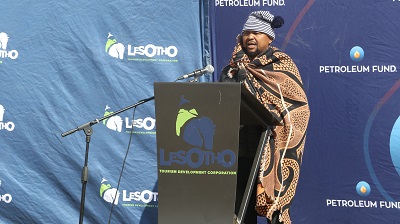By T’soloane Mohlomi
MASERU – Local renaissance group Selemo Association in collaboration with the Lesotho Tourism Development Corporation (LTDC), on Friday hosted the main celebrations of Selemo se Secha sa Basotho (Basotho New Year).
According to the Basotho traditional calendar the New Year for Basotho dawned on the 20th of July last month, the day was marked with the occurrence of a lunar solstice, whereby the moon displayed the first crescent, after a period of being wholly shaded by the earth.
The determination is made from an ancient Basotho practice of observing the character of the moon in different periodical phases, which as explained, after a period of having been wholly obscured by the circumference of the earth (Having occurred from 17th July 2023 King’s Birthday, this year), a fraction of the moon will emerge, and as legend has it according to Basotho folklore, it is first seen by the monkeys who catch its first glimpses before we get to see it.
Taken on account of traditional expert and researcher Mr Mathethebala Pitso, there are actually only three seasons (likhoeli) in the Basotho traditional year and calendar, this is in contrast and opposed to the Gregorian calendar which is widely used by Christians around the world.
Selemo according to Basotho is directly linked and cannot be separated from agriculture, and the time of the beginning of Selemo (the year) the period is directly associated with agricultural activities. During this time of the year Basotho usually hold a traditional ceremony known as “Mokete oa ho nt’sa mehoma” (Festival of the taking out of hoes) in translation “Ho lema” in Sesotho can be literally translated to the act of sowing.
After the first feast then later at the end of the planting season Basotho hold a festival known as “Ho hlatsoa Mehoma” (festival of the washing of the hoes).
“Ladies and gentlemen the question we need to ask ourselves today is how do we know when the year (ngoaha) is about to begin. When we talk about ngoaha we speak of the length of time when nature revives itself all the way through to when it dampens and displays an ending of natural life, occurring during the months of June and July.
“For us as Basotho to know how we mark and regulate our time, due to the fact that we had indeed been wronged for a very long-time, where during the end of the Month of December we would usually ululate and welcome what we thought to be the New Year. I often asked people what significant change can they point out to have occurred 59 minutes prior midnight on the last day of December.
“But in Sesotho when the year ends (ngaoha) an entire season ends and a new one begins. So I would like to enlighten you all that using the natural mechanism which Basotho used at their disposal to predict time, before the dawn of a new year the moon enters into darkness and is completely obscured by the circumference of the earth, it can remain into darkness for 2 to 3 days depending on the year.
“Focusing on the natural events leading up to the dawn of a new year, during the month of July we experience a period known as the winter solstice, after this period Basotho are now aware that the year is about to end, and they start observing the character of the moon in different periodical phases.
‘It disintegrates until it makes a crescent before it goes into darkness again the cycle continue year on year. This is a special time for Basotho where their connection with God is deemed to be profound, they introspect and ask for mercy as they embark on a year.
Mr Letunyane Thobei from The Selemo Association, said this nation was founded on the principles of peace. Making reference to the African philosophy of “Mohlomism” from The Famous Bakoena King who was a great sage, from whose principles this nation was founded upon, he said Basotho should reflect back, and seek guidance as the nation had clearly lost its way.


